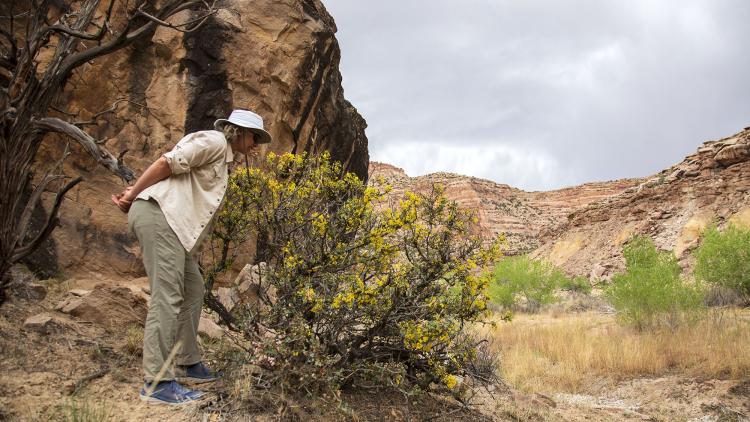Native Americans used desert holly for food, dyes and medicines
The San Rafael River cuts through the San Rafael Swell, forming the Little Grand Canyon. In early April, we were hiking upstream in the canyon when we stopped for a rest and a snack and to assess the curtain of rain that appeared to be bearing down on us.
My colleague, Professor Val McKenzie, took an interest in a woody shrub, almost five feet tall, with numerous yellow flowers. The following day, I noticed dozens of these flowering shrubs in nearby Buckskin Canyon. They seemed to be similar to but distinctly different than Oregon grape in the Front Range around Boulder.
The leaves are compound, with three to nine leaflets shaped like holly leaves, each about an inch long. The leaflets are smooth, hairless and slightly indented between the spines at the margins. The leaves are light green when young, but they mature to dark green and then senesce to a dusty greenish blue.
Flowers have six sepals and six petals, all bright yellow. The sepals spread wide, while the petals form a cup. Berries are green while developing but ripen to purple later in the season.
This woody shrub is desert holly, or Fremont's barberry. Identification and use of common names are straightforward. However, considerable controversy revolves around the scientific name of desert holly.
The species name, fremontii, has always been stable. It recognizes Army general, explorer and botanical collector John Fremont, who first collected desert holly on the bank of the Virgin River in Utah in 1844.
But the genus name has always been controversial. It was first Berberis, then Mahonia, but then the genus name Mahonia was abolished, so it was Berberis again. CU Boulder Professor William Weber (now deceased) placed it back in Mahonia, but a recent genetic study of species of Berberis and Mahonia placed it in Alloberberis, a new genus.

At the top of the page: Desert holly is a woody shrub that flowers profusely in spring and offers edible berries in fall (Photos by Jeff Mitton). Above: Ecology Professor Valerie McKenzie observes desert holly.
Discovery of the true evolutionary history of related species can be tortuous. I will refer to Alloberberis fremontii as desert holly.
It is easy to see a close relationship between desert holly and Oregon grape, Mahonia repens, for the leaves and berries are quite similar, although the growth forms are different. All of the species that were once in the genus Berberis produce berberine, an alkaloid which makes the plant distasteful and has antibiotic, antimicrobial and antifungal activities. Berberine is found in all of desert holly's tissues, with high concentrations in the roots, stems and inner bark but low concentrations in the berries.
Desert holly is native to the southwestern states, including Colorado, New Mexico, Utah, Arizona, Nevada and California, and was used by Apache, Havasupai, Hopi, Hualapai, Walapai, Navajo, Yavapai and Zuni. This is not an exhaustive list of all Native Americans within its geographic range, but I suspect that the coverage in the literature is incomplete.
The tart berries were eaten raw as food and prepared as a beverage. Berries were also made into a bitter tonic to ease ailments of the liver, to treat sore gums, as a laxative and to improve digestion.
One reference referred to the tonic as a successful treatment for Giardia. The berries were also a source of purple dye used to color the skin and decorate ceremonial implements. Berberine in roots could be extracted to yield a brilliant yellow dye used to color blankets, baskets and buckskins. Wood from the stems was fashioned to make all sorts of implements.
Neither Oregon grape nor desert holly seem to be browsed by deer or squirrels or mice, so berberine must be an effective chemical defense. But none of the hundreds of chemical plant defenses studied to date deter all species of herbivores.
Barberry geometer or barberry looper, Coryphista meadii, is a medium-sized moth with a wingspan of about 1.25 inches. It is intricately patterned in zigzagging bands of tan and brown for camouflage and has an alternate color morph with a few bands of orange. It is a larval feeding specialist on barberry species and does not feed on species lacking berberine. This pattern of egg deposition and caterpillar feeding suggests that it has found a defense against berberine and is thriving on an uncontested food source.
Native Americans and barberry geometers recognized the value of desert holly.

